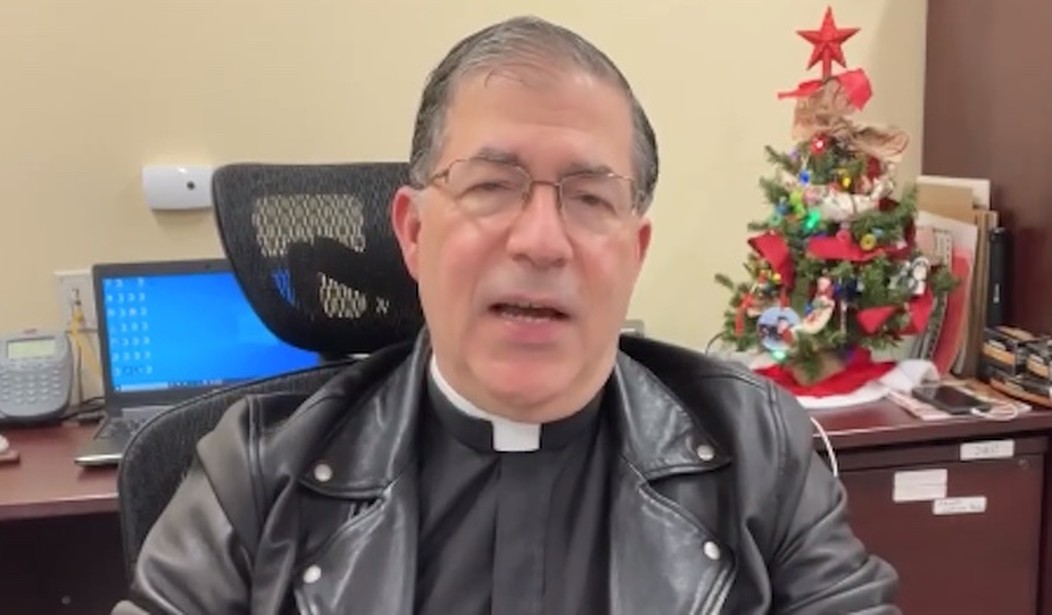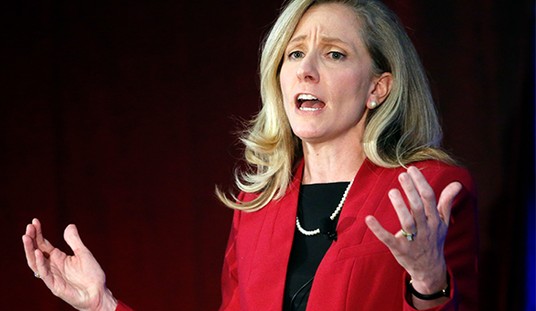It’s been two days since the Vatican officially defrocked one of the Catholic Church’s most visible pro-life activist priests, and … it’s still just as unclear what led to this harsh punishment. According to the letter to US bishops, former Father Frank Pavone committed both “blasphemous” acts as well as insubordination to his governing bishop. However, the circumstances of both charges have yet to be explained in detail.
Pavone’s defrocking nonetheless has been made irrevocable, Catholic News Agency first reported Saturday night:
Father Frank Pavone, a well-known pro-life activist and national director of the organization Priests for Life, has been dismissed from the clerical state for “blasphemous communications on social media” and “persistent disobedience of the lawful instructions of his diocesan bishop,” CNA has learned.
In a Dec. 13 letter to U.S. bishops obtained by CNA and confirmed by multiple sources as authentic, Archbishop Christophe Pierre, the apostolic nuncio to the United States, wrote that the prefect of the Dicastery for the Clergy issued the decision on Nov. 9, adding that there was “no possibility of appeal.”
“Father Pavone was given ample opportunity to defend himself in the canonical proceedings, and he was also given multiple opportunities to submit himself to the authority of his diocesan bishop,” explains a separate statement attached to Pierre’s letter. “It was determined that Father Pavone had no reasonable justification for his actions.”
Pavone, however, told CNA Saturday that he had not been notified about the Vatican’s judgment.
The USCCB received a formal notification, but apparently not with much detail either. Pavone’s priestly faculties came under the authority of the Diocese of Amarillo, Texas, currently under the authority of Bishop Patrick Zurek for the past 15 years. The diocese has previously rebuked Pavone for his activist actions, including his politicking against the Democratic Party in national elections in 2016 and 2020. Veteran Vatican reporter Francis X. Rocca provided some of that history yesterday for the Wall Street Journal:
The Vatican statement distributed by Archbishop Pierre didn’t give the name of Mr. Pavone’s bishop. Mr. Pavone has been a priest of the Diocese of Amarillo, Texas, which published statements criticizing him in 2016 and 2020, respectively, for appearing in the video with the fetus and for stating it was sinful to vote for Democrats.
The diocese called then-Father Pavone’s use of the fetus “a desecration of the altar” and apologized for “the offense and outrage caused by the video for the faithful and the community at large.”
The Diocese of Amarillo didn’t respond to requests for comment on Sunday nor did the Diocese of Orlando, Fla., where Priests for Life is located.
Presumably, these were the “blasphemous” communications at issue. The insubordination is apparently connected to the same incidents, although perhaps the Vatican and the diocese have other incidents under scrutiny. However, the incident at issue took place six years ago, not recently. (The video is reportedly disturbing, so proceed at your own risk, but no one disputes what took place.) Technically, this would likely fall under sacrilege rather than blasphemy, but either charge would be serious enough for canonical penalties, as Scott Eric Alt pointed out at the time:
Fr. Pavone makes no secret that he put that dead child up on the altar and filmed him and plastered a still on Facebook in order to lobby for a particular presidential candidate.
Is that what the altar of sacrifice in a Catholic Church is for?
No. Says Canon 1239:
An altar, whether fixed or movable, is to be reserved for divine worship alone, to the exclusion of any secular usage.
The altar is intended for a sacramental purpose, as the place where the priest celebrates Mass.
I am going to be, excuse the pun, frank: What Fr. Pavone did was a sacrilege. It is a violation of canon law, which states that the altar is consecrated for one purpose and one purpose only. It is consecrated for the Holy Sacrifice of the Mass, not so that a dead child can be placed there as part of a political stunt to lobby for a favored presidential candidate. …
In consequence, Fr. Pavone’s ordinary should suspend his faculties–at least his faculty to celebrate Mass. There is no other way to put it than that this is a sacrilege and a scandal. The human person is not a prop for a political stunt. This is an offense to the purpose for which priests are ordained to use the altar.
That is entirely correct. And the diocese should have taken action at the time, and action commensurate to the violation. Alt’s suggestions certainly fit within that paradigm. This took place in 2016, however, not this year. What actions were taken then, and what result did they produce?
It’s possible that Pavone’s bishop did impose some punishment but that Pavone refused to cooperate in the matter. Insubordination is a very big deal in the hierarchical Catholic Church; priests derive their authority from their bishop, who has the actual charism for their diocese. Priestly faculties (as well as diaconate faculties) derive from a grant from the bishop, which is why the ordained have to swear obedience to their bishop as part of their ordination. If Pavone remained stubbornly obstinate in some fashion, that would have violated the authority under which he operated.
However, one would imagine that action would have been taken at the time; even the Vatican can act with more alacrity in dealing with such situations than waiting six years. Plus, defrocking — officially “laicization” — is the harshest penalty possible under these circumstances. The Vatican could have ordered Pavone into seclusion and a life of contemplative prayer, as they have done in other cases of scandal within the Church. Perhaps they did order that and Pavone refused it, which might also account for the insubordination charge.
This result lacks requisite transparency, especially given Pavone’s wide reach in the pro-life movement. It also didn’t set well with all of the USCCB. Another Texas bishop called Pavone’s expulsion the real blasphemy:
Mr. Pavone has some supporters in the U.S. episcopate. Bishop Joseph Strickland of Tyler, Texas, responded to Mr. Pavone’s dismissal on Sunday, writing: “The blasphemy is that this holy priest is canceled while an evil president promotes the denial of truth & the murder of the unborn at every turn, Vatican officials promote immorality & denial of the deposit of faith & priests promote gender confusion devastating lives…evil.”
For now, though, no one’s saying much about the specifics of the Vatican’s order, not even Pavone, who nonetheless has referred to his dismissal as an “ecclesiastical abortion”.
Ecclesiastical #abortion.
— Fr. Frank Pavone (@frfrankpavone) December 18, 2022
Hi friends… So in every profession, including the priesthood, if you defend the #unborn, you will be treated like them!
The only difference is that when we are “aborted,” we continue to speak, loud and clear.— Fr. Frank Pavone (@frfrankpavone) December 18, 2022
Pavone also tweeted out his “daily diary” yesterday for last week, notably after his tweet from Saturday night. The video diary includes the day in which his laicization was made public. Pavone mentions celebrating Mass every day — a requirement for priests, but invalid for those in the laity — as well as a number of mundane administrative tasks around Priests for Life. Pavone does make reference to having to respond to “persecution” from “certain bishops who don’t seem to like the work we do. … I have one simple message for them: It won’t work.”
My Daily Diary for December 11th through 17th https://t.co/D4jnDCPOCK
— Fr. Frank Pavone (@frfrankpavone) December 18, 2022
To the bishops that Pavone says are “in league with the Democrats,” Pavone says, “Let me see your daily diary and what you do every hour. It might tell an interesting story.”
Needless to say, this will not sit well with the pro-life movement and the Catholics within it. They have already been unhappy with the Vatican’s lack of enthusiasm for their efforts. This will look to them like a direct frontal assault on their activism, and indeed like a “persecution” of a priest for fully engaging on pro-life campaigning. And that may well be the case; the jump to laicization for Pavone while succoring Chicago’s equally political and controversial Fr. Michael Pfleger for decades is a very curious contrast indeed.
Pfleger also involved himself with presidential politics in 2008, vociferously endorsing Barack Obama; his 2008 suspension was over public and racially tinged mockery of Hillary Clinton. In 2011, his insubordination over an assignment discussion with his bishop led to another suspension by the late Francis Cardinal George, when Pfleger threatened to go schismatic over another attempt to reassign him from Saint Sabina. Eight years later, Pfleger invited Louis Farrakhan to speak at the church, at which Farrakhan made disparaging comments about Jews. Cardinal Blaise Cupich was forced to issue an apology and a public rebuke to Pfleger. Even after all that and more — a handful of people have claimed abuse, but those allegations could not be corroborated — Pfleger is still an active priest in the archdiocese.
This kind of action requires a lot more transparency than either the Vatican or the USCCB has thus far provided. Perhaps we will see more in the coming days about Pavone’s alleged offenses and the necessity of laicization over other penalties, but until then, questions will continue to percolate over this particular action with this particular priest.








Join the conversation as a VIP Member